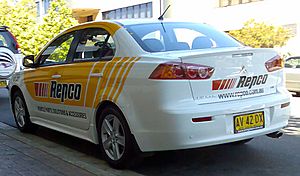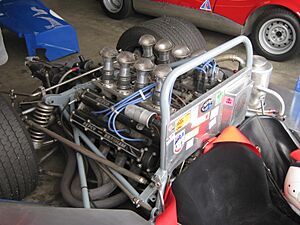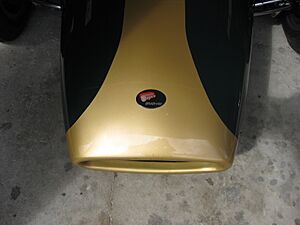Repco facts for kids
 |
|
|
Formerly
|
Automotive Grinding Company |
|---|---|
| Industry | Automotive |
| Founded | 1922 |
| Founder | Geoff Russell |
| Headquarters | Melbourne, Victoria, Australia |
|
Area served
|
Australia, New Zealand |
| Products | Auto parts |
| Services | Auto parts distributor |
|
Number of employees
|
4,000 |
| Parent | Genuine Parts Company |
| Formula One World Championship career | |
|---|---|
| First entry | 1966 Monaco Grand Prix |
| Last entry | 1969 South African Grand Prix |
| Races entered | 33 |
| Chassis | Brabham, LDS |
| Constructors' Championships | 2 (1966, 1967) |
| Drivers' Championships |
2 (1966, 1967) |
| Race victories | 8 |
| Podiums | 25 |
| Points | 126 |
| Pole positions | 7 |
| Fastest laps | 4 |

Repco is an Australian company that works with cars. Its name is short for Replacement Parts Company. For many years, Repco was known for fixing car engines and making special car parts. Today, it is mostly known as a store that sells spare parts and other items for cars.
Repco became very famous for making the engines that powered the Brabham Formula One race cars. With these engines, drivers Jack Brabham and Denny Hulme won the world championships in 1966 and 1967. The Brabham-Repco team also won the championship for car makers in those same two years.
Currently, Repco has many stores across Australia and New Zealand. These stores sell car parts and accessories.
Contents
Repco's Story
Repco was started by Geoff Russell in 1922. It first opened as the Automotive Grinding Company in Collingwood, Victoria, Australia.
In 1937, Repco became a public company, meaning its shares could be bought and sold on the Australian Securities Exchange (ASX). Later, in 1988, another company called Pacific Dunlop bought Repco, and it was no longer traded on the stock market.
In 2001, a group of investors bought Repco. After that, it became a public company again, listed on both the Australian and New Zealand Exchange stock markets. In 2006, another company, CCMP Capital, bought Repco, and it was taken off the stock market once more. On July 1, 2013, Repco and other related companies were bought by Genuine Parts Company.
Sponsoring Races
Repco loves car racing! Since 2021, Repco has been the main sponsor for two big Australian races: the Bathurst 1000 and the Supercars Championship.
Before that, Repco sponsored other racing teams like Garry Rogers Motorsport and Dick Johnson Racing. They also sponsored the 1979 Round Australia Trial, which was a long car rally around Australia. In 2024, Repco became the main sponsor for the D1NZ National Drifting Championship in New Zealand.
Repco's V8 Engine for Racing
In 1964, a new racing series called the Tasman Series started. Engines in this series could not be larger than 2,500 cc. Jack Brabham, a famous racing driver, asked Repco to help build an engine for his cars. They decided to use parts from an Oldsmobile Jetfire car engine as a base. In 1965, they built a 2.5-liter engine.
Then, in 1963, the main international racing group, the FIA, announced a big change for Formula One racing. Starting in the 1966 season, engines could be twice as big, up to three liters. Many teams were not ready for this change.
Jack Brabham asked his friend Phil Irving, an engineer at Repco, for help. They decided to make a 3-liter version of their 2.5-liter engine. The Repco company agreed to this plan. A small team at Repco, led by Phil Irving, developed the new Formula One engine.
This Repco 620 V8 engine was special because it was small and light. This meant it could fit easily into existing Formula One cars. Even though it wasn't the most powerful engine, it used less fuel, was light, and was very reliable. Because it was lighter and had less power, it put less stress on the car's parts like the brakes and tires.
Winning World Titles
In 1966, the Repco engine was good enough to help Jack Brabham win three pole positions (starting first in a race). He also won four races in a row and took home both the driver's and constructor's titles in the nine-race season. This was a unique achievement for a driver who also built his own cars.
The Repco V8 engine had a size of 2,995.58 cc. It could produce about 285 horsepower at first. Later, it was improved to produce around 299 horsepower during races. In 1967, the engine was updated again, and it could produce about 330 horsepower.
In 1967, other teams had also improved their engines. Repco made a new version of their engine, the 700 series, with a new design. Jack Brabham won two pole positions early in the year. However, a new powerful engine from Ford Cosworth appeared, which was even faster. Even though the new Ford engine was sometimes fragile, the Brabham drivers still won two races each. Denny Hulme won the driver's title, and Brabham won the constructor's title again.
More Powerful Engines
The new Ford engine made Brabham realize they needed even more power. For 1968, Repco created a new version of their V8 engine. This one had two camshafts and four valves per cylinder, aiming for more power. They hoped for 400 horsepower, but it reached about 380 horsepower. This season was difficult because the new engine had many problems and was not reliable.
Repco had spent a lot of money on the engine project and decided to stop making them. For the 1969 season, the Brabham team and most other teams started using the Ford Cosworth engine instead. A few older Brabham-Repco cars were used in the first race of 1969 by local drivers, but they didn't score any points.
Other Racing Successes
Repco was involved in Australian motor racing long before working with Brabham. In the 1950s, they helped develop engines for special cars called Maybach Specials, which won many races, including the 1954 New Zealand Grand Prix.
The Brabham-Repco project was first planned for the Tasman Series. The 2.5-liter Repco V8 engine didn't have much success in this series at first. However, Jack Brabham did win one Tasman Series race in 1967 with his Repco-powered Brabham car.
Brabham-Repco cars also raced in the Indianapolis 500 in 1968 and 1969. In 1969, Peter Revson finished fifth in a Repco-powered car and won another USAC race that year.
In 1969, Leo Geoghegan won the first Japanese Automobile Federation (JAF) Grand Prix in Japan. His car was a Lotus 39 powered by the 2.5L Repco V8 engine.
Repco also made other versions of their V8 engine, including a 4.3-liter engine for sports car racing and a turbo-charged version. These didn't have much international success. However, the sports car engine (later increased to 5.0 liters) was very successful in Australia. It powered cars that won many races, including those built by Frank Matich and Garrie Cooper.
Repco Brabham Racing Cars
When Jack Brabham started building his own racing cars in England, he called them Repco Brabhams. This was part of a sponsorship deal between Brabham and Repco. The cars kept this name even if they used a different engine. This agreement helped Repco promote its car parts and services around the world because of Brabham's racing wins.
Formula 5000 Engines
Repco Holden Engines
Repco also designed and built the Repco-Holden engine for Formula 5000 racing. They used parts from the Holden 308 V8 engine as a base, but they made many changes. These included special fuel injection and ignition systems, plus over 150 unique parts designed by Repco. This engine first won a big race in 1970, the 1970 Australian Grand Prix, with Frank Matich driving.
The Repco-Holden engine was used a lot in many different racing cars. By 1976, the 4940 cc Repco-Holden V8 engine could produce about 500 horsepower.
The Repco-Holden Formula 5000 engine won many races and championships, including:
- Australian Grand Prix: 1970, 1971, 1976
- Australian Drivers' Championship: 1972, 1973, 1975
- New Zealand Grand Prix: 1973, 1974
- Australian Sports Car Championship: 1975
- Australian Sports Sedan Championship: 1980
- Australian Tourist Trophy: 1976
Repco Leyland Engines
After the Repco Holden engine's success, racer John McCormack looked for a lighter engine. In 1974, he and engineer Phil Irving found the 4.4L alloy engine from the Leyland P76 car. This engine was much lighter than the Holden and Chevrolet engines.
Repco modified this engine, making it larger to 4931 cc. After three years of work, the Repco-Leyland V8 produced around 470 horsepower by 1977. While this was less powerful than the Holden and Chevrolet engines, it weighed only 160 kg, much lighter than the 220 kg Holden engine.
In 1976, McCormack bought a McLaren M23 Formula One car. He chose the Repco Leyland engine because its light weight was similar to the engine the car was designed for. This helped the car handle better.
John McCormack won the 1977 Australian Drivers' Championship with the Repco-Leyland engine. However, this engine was known to be less reliable than the Chevrolet and Holden V8s.
Formula One World Championship Results
Repco's engines helped Brabham win two constructor titles and two driver titles in Formula One.
| Year | Team | Driver | # of GPs | WC |
|---|---|---|---|---|
| 1966 | Brabham-Repco | Jack Brabham | 9 | World Champion |
| Brabham-Repco | Denny Hulme | 7 | 4th | |
| 1967 | Brabham-Repco | Denny Hulme | 11 | World Champion |
| Brabham-Repco | Jack Brabham | 11 | 2nd | |
| Brabham-Repco | Guy Ligier | 5 | ||
| 1968 | Brabham-Repco | Jochen Rindt | 12 | 12th |
| Brabham-Repco | Jack Brabham | 11 | 23rd | |
| Brabham-Repco | Silvio Moser | 4 | 23rd | |
| Brabham-Repco | Dan Gurney | 1 | ||
| Brabham-Repco | Dave Charlton | 1 | ||
| Brabham-Repco | John Love | 1 | ||
| Brabham-Repco | Kurt Ahrens Jr. | 1 | ||
| LDS-Repco | Sam Tingle | 1 | ||
| 1969 | Brabham-Repco | Peter de Klerk | 1 | |
| Brabham-Repco | Sam Tingle | 1 |



